10
Principles of Ergonomics
©Dan MacLeod, 1990, 2008
For published versions of the
following information, see
Training Materials. You may also license this material for
in-house training. Contact Dan for more professional looking
layouts, higher quality images, and additional formats such as
PowerPoint presentations..
The field of physical ergonomics can be summarized in a series of principles. You will very
readily see that you can apply these principles at work, at home, or any other place.
| Putting on Your Ergonomics Glasses The
basics of ergonomics do not need to be hard. Much of it amounts to looking at routine
activities from a new perspective — putting on your ergonomics glasses. |
 |
Principle
1
Work in Neutral Postures
Your posture provides a good starting point for evaluating the tasks that you do.
The best positions in which to work are those that keep the body "in neutral."
|
Maintain the "S-curve" of the spine
Your spinal column is shaped more or less like an "S."
|
 |
| It is important to maintain the natural S-curve of the back, whether
sitting or standing. The most important part of this "S" is in the lower back,
which means that it is good to keep a slight "sway back,"
When standing,
putting one foot up on a footrest helps to keep the spinal column in proper alignment. |
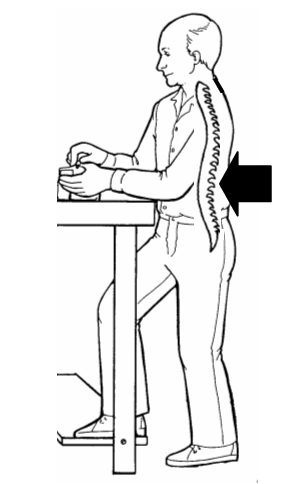 |
|
Working
for long periods with your back in a “C-curve” can place strain on your
back. Good lumbar support is often helpful to maintain the
proper curve in the small of
your back. |
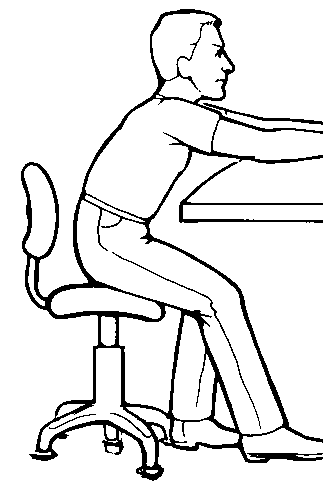
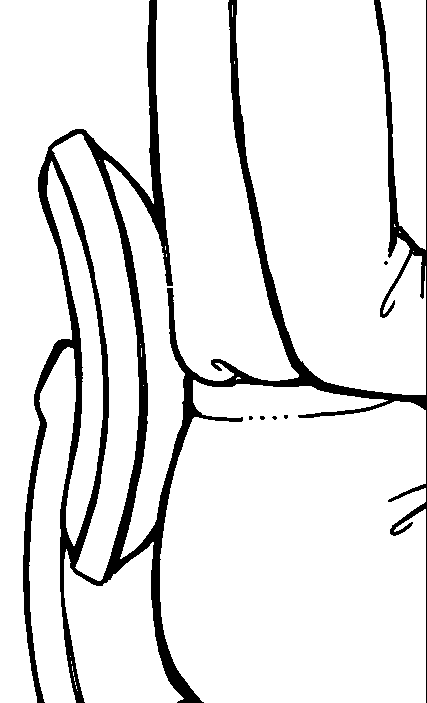 |
|
The
“Inverted V-curve” creates an even greater strain on your back.
Even without lifting a load, bending over like this creates a great deal
of pressure on the spine.
One common improvement is to use a lifter or tilter. Or there may be
other ways of making improvements depending upon the situation. |
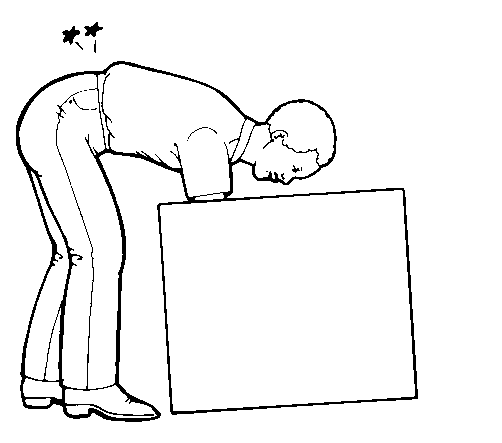 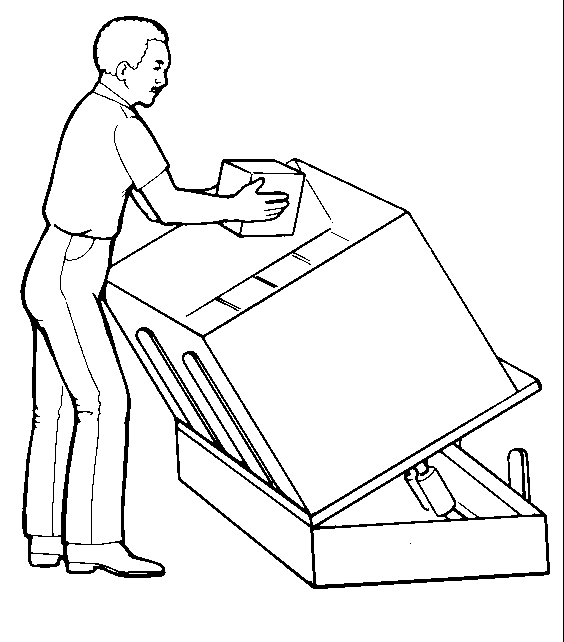 |
|
Keep the neck aligned
The neck bones are part of the spinal column and thus are subject to the same
requirements of maintaining the S-curve. Prolonged
twisted and bent postures of the neck can be
as stressful as its equivalent for the lower back.
The best way to make changes is usually
to adjust equipment so that your neck is in its neutral posture. |
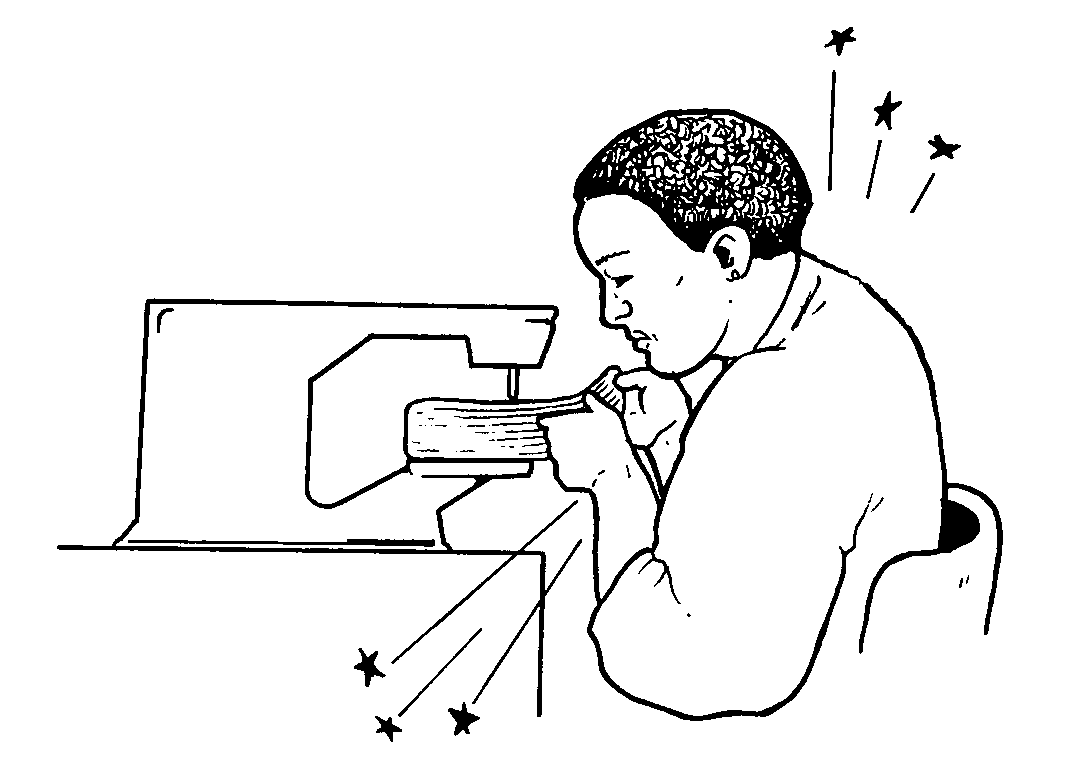
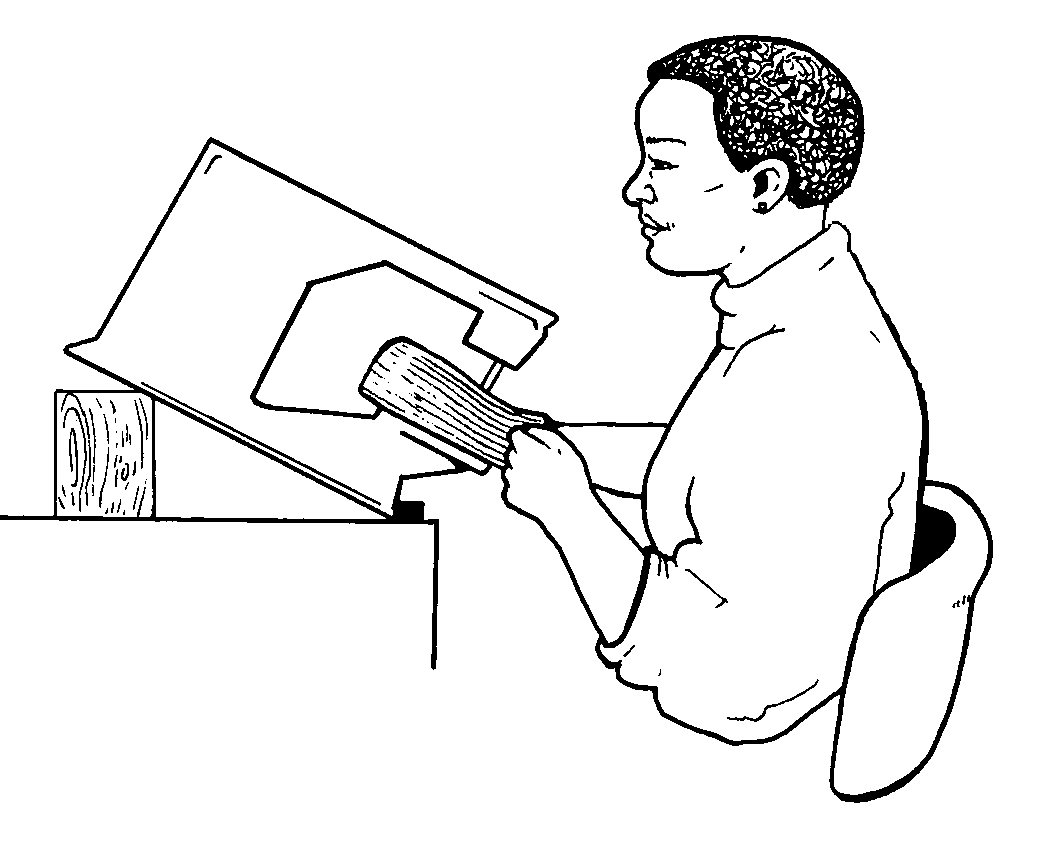 |
|
Keeps elbows at sides
The neutral posture for your arms is to keep you elbows at your sides and your
shoulders relaxed. This is pretty obvious once you think about it, but we don’t
always do it. |
 |
| Here’s an example of changing a workstation to get the arms in
neutral. In the illustration at the left, the product is too high, and the employee is
hunching her shoulders and winging out her elbows.
In the right-hand illustration, the
product has been reoriented and the shoulders and elbows drop to their relaxed position.
|
 |
Keep Wrists in
Neutral
There are several good ways to think about wrist posture. One way is to keep the hand
in the same plane as the forearm, as this person is doing here by using a wrist rest along
with the computer mouse. |
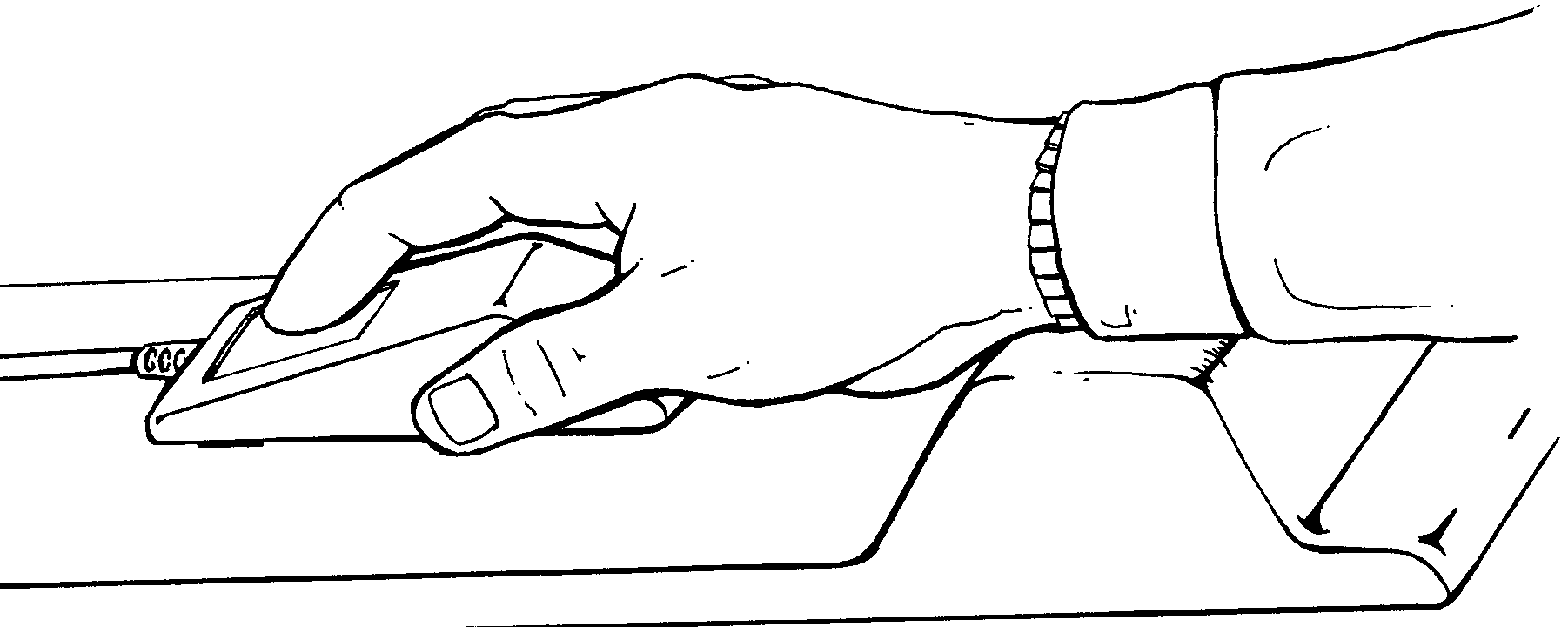 |
| A slightly more accurate approach is to keep your hands more or less like
they would be when you hold the steering wheel of your car at the 10 and 2 o’clock
position — slightly in and slightly forward. |
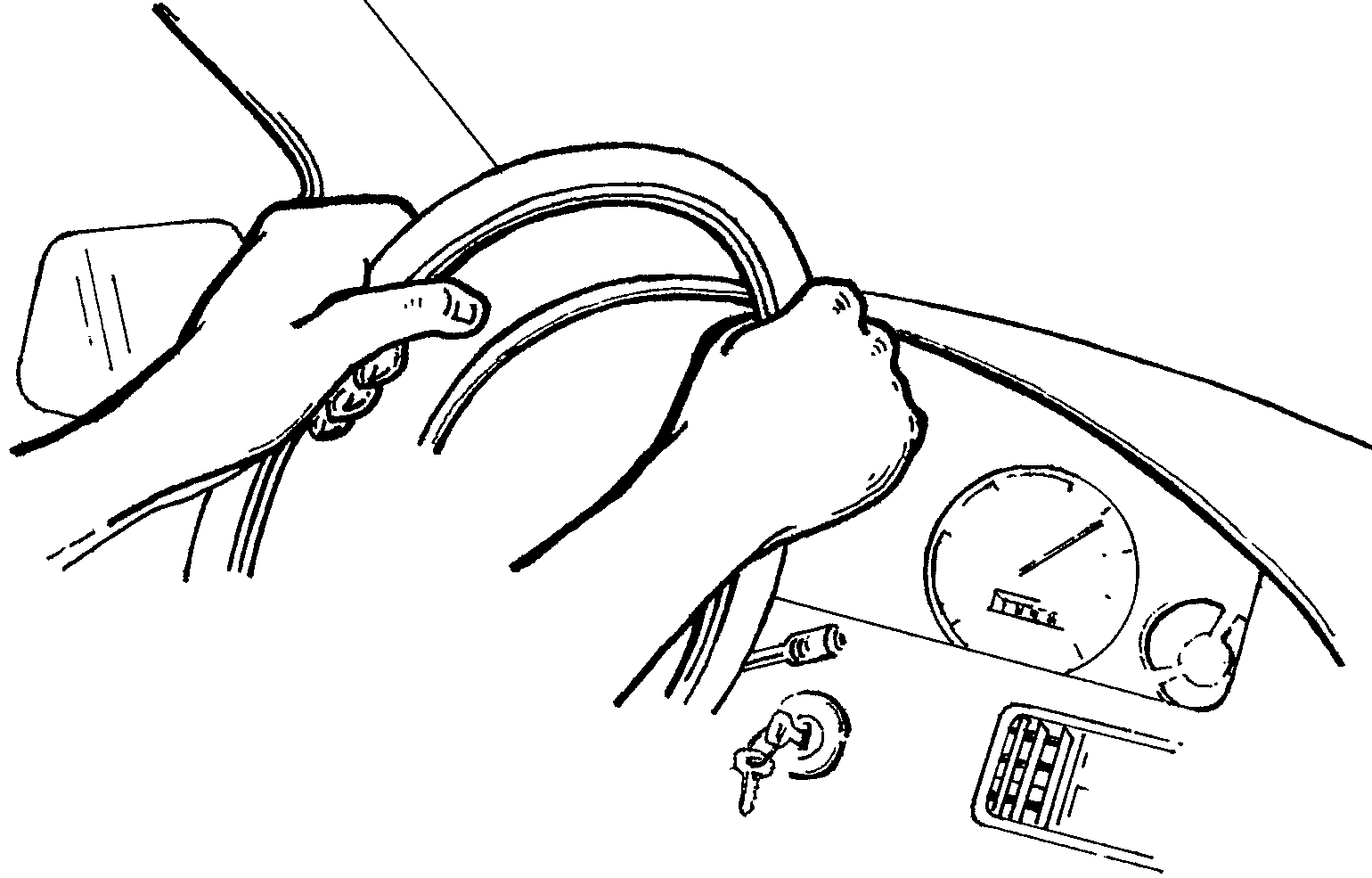 |
| Here’s an example of how this principle applies to tool design.
Working continuously with the pliers as shown in the left-hand picture can create a lot of
stress on the wrist. By using pliers with an angled grip, however, the wrist stays in its
neutral posture. |
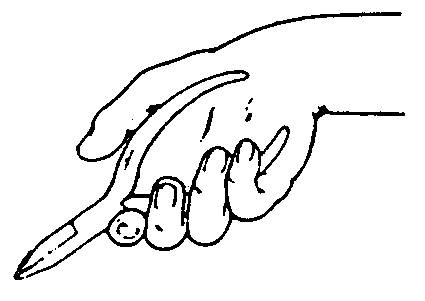
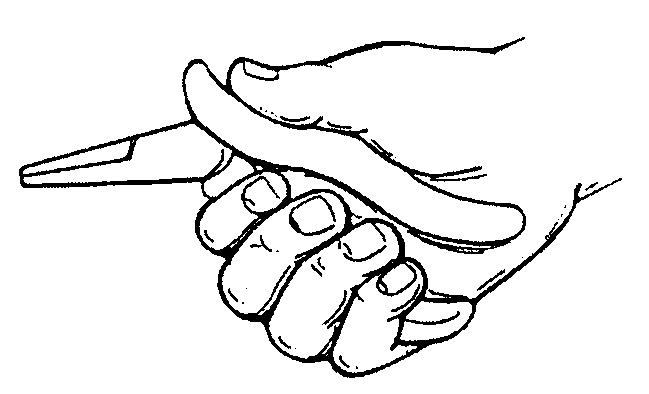 |
Reduce Excessive Force
Excessive force on your joints can create
a potential for fatigue and injury. In practical terms, the action item is for you
to identify specific instances of excessive force and think of ways to make improvements.
| For example, pulling a heavy cart might create excessive force for your
back. To make improvements it might help to make sure the floor is in good repair, that
the wheels on the cart are sufficiently large, and that there are good grips on the cart.
Or a power tugger might be needed. |
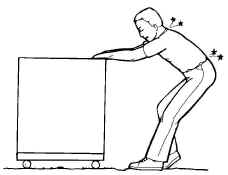 |
| Or another example of reducing force is to use a hoist for lifting heavy
objects, like this vacuum hoist in the drawing. |
 |
| Another kind of example is having handholds on boxes or carrying totes.
Having the handhold reduces the exertion your hands need to carry the same amount of
weight. |
  |
|
Point:
There are thousands of other examples and the field of
ergonomics includes much information on conditions that affect force. The basic point is
to recognize activities that require excessive force, then think of any way you can to
reduce that force. |
Keep Everything in Easy Reach
The next principle deals with keeping things within easy reach. In many
ways, this principle is redundant with posture, but it helps to evaluate a task from this
specific perspective.
Reach Envelope
One concept is to think about the "reach envelope." This is the semi-circle
that your arms make as you reach out. Things that you use frequently should ideally be
within the reach envelope of your full arm. Things that you use extremely frequently
should be within the reach envelope of your forearms. |
 |
| Much of the time, problems with reach are simply matters of rearranging
your work area and moving things closer to you. This is not exactly a hard concept to
grasp; what is difficult is having the presence of mind to notice and change the location
of things that you reach for a lot.
Often it is a matter of habit — you are unaware
that you continually reach for something that could be easily moved closer.
|
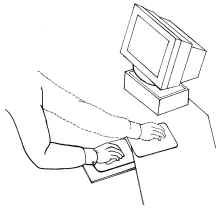 |
| Or sometimes, the work surface is just too big, causing you to reach
across to get something. One option is just to get a smaller surface. Another option is to
make a cutout — this way your reaches are cut, but you still have plenty of space for
things. |
 |
| Or another common problem is reaching into boxes. A good way to fix this
is to tilt the box. Once again, there are thousands of other examples of ways to reduce
long reaches. The point is for you to think about when you make long reaches, then figure
out how to reduce that reach. |
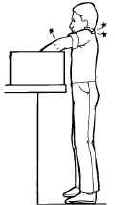 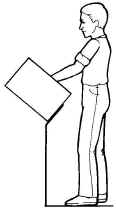 |
Work at Proper Heights
Working at the right height is also a way to make things easier.
|
Do most work at elbow height
A good rule of thumb is that most work should be done at about elbow height, whether
sitting or standing.
A real common example is working with a computer keyboard. But, there are many other
types of tasks where the rule applies. |
 |
|
Exceptions to the Rule
There are exceptions to this rule, however. Heavier work is often best done lower than
elbow height. Precision work or visually intense work is often best done at heights above
the elbow. |
 |
| Sometimes you can adjust heights by extending the legs to a work tables or
cutting them down. Or you can either put a work platform on top of the table (to raise the
work up) or stand on a platform (to raise YOU up).
Or to be a little more complicated,
there are ways to make stands and work tables instantaneously adjustable with hand cranks
or pushbutton controls. |
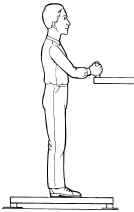  |
Principle
5
Reduce Excessive Motions
The next principle to think about is the number of motions you make throughout a
day, whether with your fingers, your wrists, your arms, or your back.
Principle 6
Minimize Fatigue and Static Load
Holding the same position for a period of time is known as static load. It
creates fatigue and discomfort and can interfere with work.
| A good example of static load that everyone has experienced is
writer’s cramp. You do not need to hold onto a pencil very hard, just for long
periods. Your muscles tire after a time and begin to hurt. |
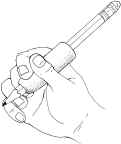 |
| In the workplace, having to hold parts and tools continually is an example
of static load.
In this case, using a fixture eliminates the need to hold onto the part. |
 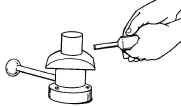 |
| Having to hold your arms overhead for a few minutes is another classic
example of static load, this time affecting the shoulder muscles. Sometimes you can change
the orientation of the work area to prevent this, or sometimes you can add extenders to
the tools. |
 |
| Having to stand for a long time creates a static load on your legs. Simply
having a footrest can permit you to reposition your legs and make it easier to stand.
We’re
going come back to this point later. |
 |
Minimize Pressure Points
Another thing to watch out for is excessive pressure points, sometimes called
"contact stress."
| A good example of this is squeezing hard onto a tool, like a pair of
pliers. Adding a cushioned grip and contouring the handles to fit your hand makes this
problem better. |
  |
| Leaning your forearms against the hard edge of a work table creates a
pressure point. Rounding out the edge and padding it usually helps. |
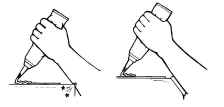 |
| We’ve all had to sit on chairs that had cushioning and so understand
almost everything we need to know about pressure points. A particularly vulnerable spot is
behind your knees, which happens if your chair is too high or when you dangle your legs.
Another pressure point that can happen when you sit is between your thigh and the bottom
of a table. |
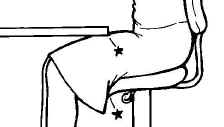 |
| A slightly more subtle kind of pressure point occurs when you stand on a
hard surface, like concrete. Your heels and feet can begin to hurt and your whole legs can
begin to tire. The answer is anti-fatigue matting or sometimes using special insoles in
your shoes. Like the other basic principles that we’ve covered so far, pressure
points are things that you can look for in your work areas to see if there are ways to
make improvements. |
 |
Provide Clearance
Having enough clearance is a concept that is easy to relate to.
| Work areas need to be set up so that you have sufficient room for your
head, your knees, and your feet. You obviously don’t want to have to bump into things
all the time, or have to work in contorted postures, or reach because there is no space
for your knees or feet. |
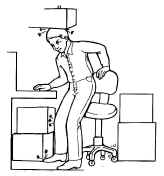 |
| Being able to see is another version of this principle. Equipment should
be built and tasks should be set up so that nothing blocks your view. |
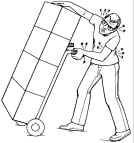 |
Move, Exercise, and Stretch
To be healthy the human body needs to be exercised and stretched.
| You should not conclude after reading all the preceding information about
reducing repetition, force, and awkward postures, that you’re best off just lying
around pushing buttons. Muscles need to be loaded and your heart rate needs periodic
elevation. |
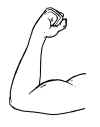 |
Depending upon the type of work you do, different exercises on the job can
be helpful.
- If you have a physically demanding job, you may find it helpful to stretch and warm up
before any strenuous activity.
- If you have a sedentary job, you may want to take a quick "energy break" every
so often to do a few stretches.
|
 |
If you sit for long periods, you need to shift postures:
- Adjust the seat up and down throughout the day.
- Move, stretch, and change positions often.
|
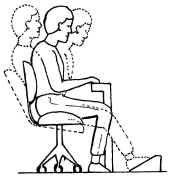 |
| It actually would be ideal if you could alternate between sitting and
standing throughout the day. For some tasks, such as customer service, desks are available
that move up and down for this purpose (this is not new; Thomas Jefferson built a desk
like this for himself). |
 |
Principle 10
Maintain a Comfortable Environment
This principle is more or less a catch-all that can mean different things
depending upon the nature of the types of operations that you do.
|
Lighting and Glare
One common problem is lighting.
In the computerized office, lighting has become a big issue, because the highly
polished computer screen reflects every stray bit of light around.
|
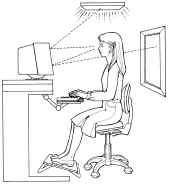 |
| But many other types of tasks can be affected by poor lighting, too.
Concerns include glare, working in your own shadow, and just plain insufficient light.
One
good way to solve lighting problems is by using task lighting; that is, having a small
light right at your work that you can orient and adjust to fit your needs. |
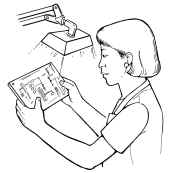 |
Vibration
Vibration is another common problem that can benefit from evaluation. As an example,
vibrating tools can be dampened. |
 |
Note: The above principles all address physical issues, those items that
people are most interested in currently. Two additional "principles" are:
11. Make displays and controls understandable
12. Improve work organization
These last two "principles" are in fact huge topics that in
themselves can be summarized in a series of principles.
|
